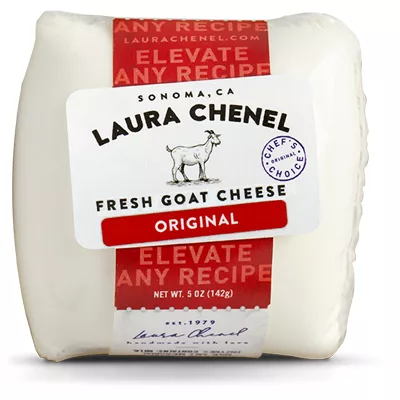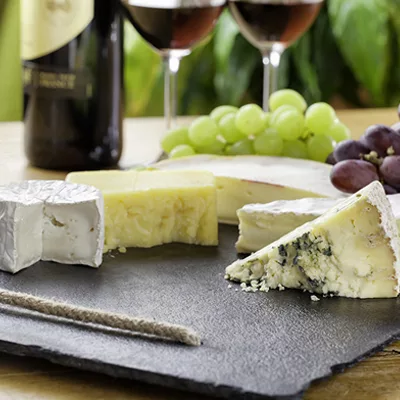
ALL ABOUT GOAT CHEESE
GOAT CHEESE
Tangy. Creamy. Simple. Goat cheese singlehandedly adds oomph to any dish. Goat Cheese or chèvre, which means goat in French, is cheese made from goat's milk. Goat cheese tastes tarter than cheese made from cow's milk because goat's milk has a higher proportion of fatty acids such as caproic, caprylic, and capric acid, which helps sharpen the flavor. It is lower in fat and calories than other traditional cheeses. The great appeal of goat cheese is that it complements many dishes – it can be crumbled into a salad, used in a sandwich, melted on a flatbread, or sprinkled on a pizza.

HOW GOAT CHEESE IS MADE
The goat milk goes in a steam-heated pasteurization tank where an agitator stirs the milk non-stop to keep it from cooking. The milk is heated to 66°C or 150 °F, which destroys any bacteria. Bacterial cultures are added when the milk is pasteurized, which kickstarts the fermentation. Rennet or Microbial Rennet, which contains enzymes that help curdle the milk, is also added. The milk is left to ferment for 18 hours. After 18 hours, cheese curds and a watery liquid called whey develops. Curds are put into a cheesecloth bag and strained. After straining, the curds sit for another 18 hours, followed by another straining round. It is then weighed and salted with about 0.6% of salt to slow the cheese's aging process. Like a fine wine, goat cheese gets better and tastier with time.
HISTORY AND ORIGIN
The origin of goat cheese dates back almost 9,000 years ago. Goat cheese originated in the Mediterranean and Middle East in areas where goats were more plentiful than cows, especially in areas with rough terrain. In what is now Iran, Villagers made an informal deal with wild goats; they would herd, feed, and protect them in exchange for meat, milk, hides, etc. Goats were even incorporated into religious deities and rituals and served as a form of currency, with dowries paid and wealth measured in goats.
Long referred to as "the poor man's cow" because they are foragers, not grazers; goats can thrive on rough land that couldn't support the hardiest cow. Because of this and the ease of making it, goat cheese has long been considered peasant's fare.
In the 8th century A.D, the Moors brought goats to the Loire Valley, where French goat cheeses were first made. Farmers who used fresh goat's milk to make cheese have referred to it as chèvre for centuries, and the use of the word spread with the cheese's popularity. Today goat's milk is used to make cheese across the globe, from small artisanal farms to mass production.


USES
Goat cheese is made in many shapes, sizes, flavors, and textures - from soft and fresh cheese to hard and aged. Young goat cheese is fresh, mild, creamy, and spreadable, whereas aged goat cheese tends to be more complex and sharper. Often, softer varieties of goat cheese are rolled into fruits, nuts, spices, chopped herbs, or even edible flowers.
Compared to similar cheeses such as cream cheese made from cow's milk, goat cheese is lower in fat, cholesterol, and calories and higher in calcium. Goat cheese is also more easily digested by humans than cheeses made from cow's milk, which is beneficial for those with lactose intolerance.
There are many ways of serving goat cheese, such as crumbling it on salads, melting it into cooked dishes, or simply serving it with warmed bread. Goat cheese melts differently than cow's milk cheese, and harder varieties are often baked and transformed into a gooey warm spread that may be served with garlic and bread. The French call this preparation "chevre chaud."
Sources:
1. How It’s Made. (2018) “How It's Made Goat Cheese.” Accessed May 19, 2022.
2. Chaey, Christina. (2017). “25 Goat Cheese Recipes That Are Tangy & Creamy.” Accessed May 19, 2022.
3. CookingLight. (2016). "39 Ways to Use Goat Cheese.” Accessed May 19, 2022.
4. igourmet. (2021). "Goat Cheese – Cheese Guide." Accessed May 19, 2022.
5. I Love Imported Cheese. (2019) “The History and Uses of Goat Cheese.” Accessed May 19, 2022.


